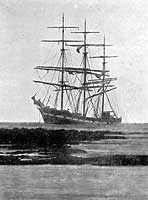 |
| Home | Wreck Locations | Wrecks Gallery | Lifeboat Locations | Atherfield Gallery | Brighstone Gallery | Brook Gallery |
| Coxswains | Awards & Medals | Atherfield Journal | Brighstone Journal | Brook Journal | Headstones | Links | Info Wanted |
 | Sirenia | ||||||||
| Came to grief: 9th March 1888 at/near Atherfield Ledge | |||||||||
| Captain MacIntyre | |||||||||
| Cargo: wheat | |||||||||
| Crew of 25 | |||||||||
| Carrying 5 passengers | |||||||||
| |||||||||
Sirenia under the command of Captain MacIntyre, out of San Francisco, via Cape Horn bound for Dunkirk with 25 crew as well as the Captain, his wife, their 3 children and their woman servant. The Sirenia was a three masted, full rigged ship with a strong iron and steel hull, weight 1,588 tons. On the afternoon of March 9th 1888 she ran aground under full sail in a dense fog and surprisingly heavy sea, for there was no wind. The alarm was raised by Harry Cotton who was walking along the shore. Harry was the son of Rufus Cotton, who immediately alerted the rest of the Brighstone Lifeboat crew. The Worcester Cadet, Coxswain Moses Munt, launched soon after 4pm into a heavy sea, but still no wind. After an hour of being soaked by large, icy swells, the children and the two women were taken to shore, safely beached at 6.30pm. Munt agreed with MacIntyre to return for the crew at low tide, it being very dangerous to land a full boat at high tide in such a swell. Six miles away, at Brook, the William Slaney Lewis was pulled out, but the Coxswain, John Hayter, decided it was too dangerous to launch from the bottom of the chine. The carriage was wheeled out on to the Military Road and pulled to Brighstone. They launched from Grange Chine, but were immediately capsized, breaking oars and injuring two men. It took an hour to get the boat back on the carriage. It was then hauled to Chilton Chine, manhandled down to the sea and successfully launched. Back at Atherfield the wind was getting up and the swells continued. Munt decided there was no time to lose and launched at low water, just after midnight. The Worcester Cadet reached the Sirenia, sometimes level with the rail, sometimes twenty feet below. Thirteen men were ready to be taken off, and all eventually managed to jump in or slide down ropes. Just when the lifeboat cast off, a huge wave, bigger than any before, lifted its bow almost to the vertical. Men fell towards the stern, crashing on to Munt. That wave having passed, the boat was broadside to the next, which capsized it, throwing men into the water. 22 of the 26 men scrambled back on board after the lifeboat righted but both Moses Munt and Thomas Cotton (2nd Cox) along with one of the Sirenia crew were missing. A second Sirenia crewman, Leonard Procter Dozier, was found entangled in the ropes when the lifeboat righted itself, but he was dead. The William Slaney Lewis was 300 yards from the Sirenia when she too was struck by a monstrous wave which carried the 2nd Coxswain Reuben Cooper and the two Jacobs brothers, Ben and Phil, into the sea. The Jacobs brothers were hanging on to ropes and were soon hauled back on board but Reuben Cooper could not be found. The search was eventually abandoned and with an exhausted crew, the Coxswain was obliged to drop anchor and wait for dawn. The weather had not improved. After a long fruitless struggle, Hayter was forced to give up his attempt. He set sail and headed back to Brook. The William Slaney Lewis had been out for fifteen hours. Only three of the Worcester Cadet crew were capable of making a third trip out to the Sirenia. Their officers were dead so Rufus Cotton was chosen as Coxswain. The other two were David Cotton and Frank Salter who was just 19. Among the new crew was Edmund Attrill, the Coxswain of the Bembridge boat, who had walked 15 miles across the Island to assist. Two others came from Sandown and one from Ventnor. Walter White, later Atherfield Coxswain, Fred Bastiani, a notorious local smuggler, John Cotton, Percy Wheeler and Charles Orchard made up the rest of the crew. She launched at noon and successfully returned to the beach with the remaining crew two hours later. The bodies of Moses Munt and the Sirenia crewman were washed ashore that evening, but the body of Tom Cotton was not found until a few days later, being washed up at the foot of Blackgang Chine. Gravestones marking Moses Munt, Leonard Dozier and Thomas Cotton can still be seen in Brighstone Churchyard. The Royal National Lifeboat Institution held its customary enquiry and analysed the decisions of the two Coxswains. Both Hayter and Monk were exonerated. John Hayter, Rufus Cotton, David Cotton and Frank Salter received silver medals for their part in the rescue. A new station was set up at Atherfield just over two years later and the lifeboat, the first Catherine Swift, came into service on 27th October 1890. (see 1892 Eider). | |
Fatalities: 5 | |
Bibliography: Back of the Wight - Fred Mew Shipwrecks of the Wight - J.C.Medland Shipwrecks of The Isle of Wight - Ken Phillips The Lifeboats of Brighstone Bay - Christopher J. Willis and Edward H. Roberts |